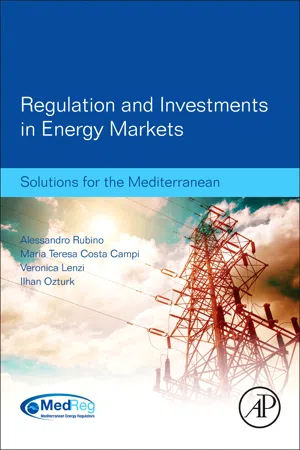1. Introduction
Analysis of the success of electricity sector reform in the EU and its transferability into the South East Europe (SEE) Energy Community (EC) is twofold. The first aspect is general – it analyzes the possibility of transferability of the concept. The concept was designed in such a way that certain sectoral reforms and policies were first to be implemented in the European Union (EU) and then replicated through a system of institutions such as the SEE EC by EU accession countries. The second aspect looks at individual solutions, such as sectoral strategies, regulatory mechanisms, and individual legislative provisions implemented in practice. The two perspectives are necessary as they allow us to identify the root of the problem. As a result, failure of the concept cannot be blamed on poor individual solutions and, vice versa.
This chapter aims to analyze the following: first, the mechanisms behind investment incentives in the transmission or, to be more precise, in the interconnection infrastructure of electric power systems; second, the possibility of this set of mechanisms establishing a model or any other formal framework and, last, to provide a discussion on the transferability of such a model or concept. The discussion has a strictly regional perspective since it addresses the interconnector infrastructure (i.e., the mechanisms of investment incentives in the interconnectors are considered as measures that have to be undertaken by two or more countries constituting a given region).
Starting with Pollitt (2007), there have been a number of papers (Petrov, 2007; Monastiriotis, 2008; Uvalic, 2009; Zuokui, 2010; Haney and Pollitt, 2010) that have analyzed the issue of transferability of the concept of EU energy sector reform, including its application in the SEE EC region. However, our dilemma concerns a set of more specific issues. Namely, one of the objectives of this chapter is to check whether it is possible to identify incentives in the transmission system implemented in the EU as well as those subsequently transposed to the EC that have a regional character from among the mechanisms for investments; whether their system-level application can result in a model; what the necessary level of harmonization for these mechanisms is, and whether the model so established may be transferred elsewhere so as to become a kind of matrix to encourage investment in other developing regions. Therefore, Pollitt’s thesis was only a trigger or an inspiration for this kind of approach. It is not the intention in this chapter to discuss Pollitt’s thesis itself, which is essentially broader and multivalent.
Studies, materials, and evaluations mainly published from 2008 onward were used to verify this thesis. Earlier assessments or materials were avoided because the EC effectively started its operation in 2006 and the more serious work on incentive mechanisms started only in 2009. Following a review of all applied or recommended incentive mechanisms, the focus was then placed only on those mechanisms that could be applied within a regional framework. Therefore, incentive mechanisms have not been analyzed according to their effects or strengths such as regulatory ex ante tests, incentive mechanisms that provide incentives to reduce costs, various exemptions from regulation related to rates of return, tendering for new investments to encourage investment from independent investors, or regulatory asset base (RAB) determination. Our thesis is that these types of incentives may be applied anywhere, at any time, in any country – but it is not natural to expect countries in any region, no matter how compact that region may be, to implement these incentive schemes in the same way, with the same intensity, and to the same extent. Therefore, they have a national character – not a regional one. Naturally, the existence of a harmonized set of incentive schemes would be ideal for investment and we should strive to achieve it, but we believe that cannot be achieved in practice because of the social, political, economic, and, above all, technical differences among energy systems.
2. Background of the EC concept
The EC is a unique international institution based on a legally binding framework for contracting parties in accordance with the highest European legal standards and proven EU experience in energy market modeling. By signing the Treaty in 2005, the EU expanded its mission of “a common voice” in the energy sector into SEE countries.
Looking at the energy sector from the perspective of the EU, the SEE region is interesting both in itself and as part of the broader geopolitics of energy. First, this region has significant energy potential, especially when it comes to renewable energy sources, opening new markets, and so on. Second, since this region is one of the routes toward bigger and more significant energy sources and markets, its geographical position secures it an important geopolitical role. Third, the EU does not like to see unstable zones (in either political or energy terms) on its borders. Fourth, most countries in this region aspire to become members of the EU. Given all this, there is no doubt that the EU both needs and has an interest in making this region compatible with the EU.
From the perspective of the small transitional countries of the SEE region, their small and mutually nonconnected markets, developing institutions, and ...
